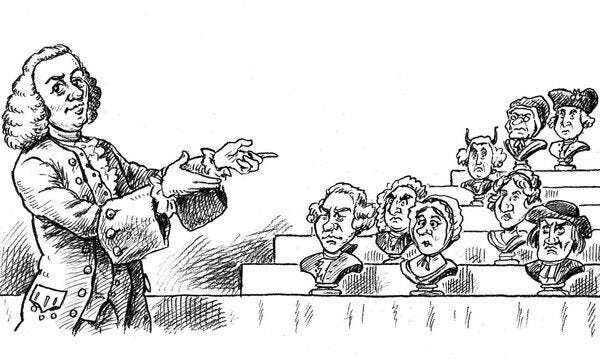
Amongst the formative experiences of my childhood are the regular trips I used to take to the workshop that produced extraordinary caricature puppets for the satirical 1980s TV show Spitting Image.
From the age of ten, and with the kind permission of the obscenely talented caricaturists Peter Fluck and Roger Law, and its brilliant producer John Lloyd (who also created Not the Nine O'clock News, Blackadder, and QI), I would poke around excitedly in the huge puppet storage room, and get under the overworked caricaturists' feet, until they set me small drawing and sculpting projects to keep me occupied. Without the encouragement and tutelage I received at the workshop, I'm not sure I would have pursued a career as a caricaturist, and Lloyd, Fluck and Law changed my life immeasurably with their random act of kindness. Like everyone else, I used to think of Spitting Image as a startlingly original concept. But when I began research for The Gin Lane Gazette, I soon came to realise that, as with so much else, the innovative Georgians had got there first.
From the mid-1760s, an enterprising chap called Alexander Stevens delighted London and the provinces with his Lecture upon Heads. It was a one-man show presenting satirical observations on a wide range of the people who comprised the nation's ranks, professions, trades, and ruling class.
On a table set before his public, Stevens displayed a great number of portrait heads, rendered in wood and papier mâché, and the apparel and physiognomy of each was representative of character types that would have been very familiar to Georgian audiences. Amongst the butts of his mockery were politicians from the coalition government, pettifogging lawyers, quack physicians, clergymen, fashionable ladies, prostitutes, the military, Billingsgate fishwives, academics, artists, stockjobbers, and various incarnations of Johnny Foreigner. All professional folk were caricatured for the public's amusement, and Stevens imitated their voices and mores, peppering his spiel with indelicate wordplay. One critic offered the caveat that connoisseurs of wit and humour, having such weak nerves that they were apt to faint away at the sound of a pun, should not to attend a performance without a stock of smelling salts. In one of his infamously terrible puns, Stevens marketed his show as a 'Caput-all Exhibition'.

Stevens first gave his Lecture at the Little Theatre in the Haymarket, in April, 1764, and it became so popular by 1772 that he once gave sixteen performances there in a little over a month. He also took the show on tour to many towns and cities, including Manchester, Bristol, Dublin, and Stratford-upon-Avon, acting as intermediary with the good burghers of Shakespeare's home town in the negotiations between them and David Garrick, concerning the celebrated actor's presentation of a statue of the Bard to the Town Hall. A spin-off book of the Lecture was published by Stevens in 1765, and it ran to several editions, many of which were pirated. The format of the Lecture was also plagiarised by some of the theatrical world's more opportunistic performers.
The financial rewards Stevens enjoyed with his Georgian forerunner of Spitting Image were estimated at a considerable £10,000, and greatly improved both his circumstances, and his reputation, which had hitherto been that of a feckless libertine and debtor, and of the maladroit author of countless bawdy songs and obscene treatises. Until the year 1764, Stevens had been an unremarkable actor in Garrick's theatrical company at Drury Lane, and a member of many boisterous London clubs. He once threw a waiter out of a window, and instructed the landlord of the house to add the loss of the poor blighter to his bill.
By the 1770s, he seems to have been constructing, operating, and voicing life-sized puppets for the one-legged theatre impresario, Samuel Foote, and penning many a comic opera. In about 1780, he sold his hugely popular Lecture as a going concern to an actor called Charles Lee Lewes, but it was never as successful under its new caretaker. Stevens died in 1784, and was buried at Biggleswade in Bedfordshire.
The Gin Lane Gazette on sale now!